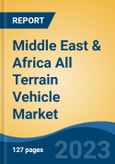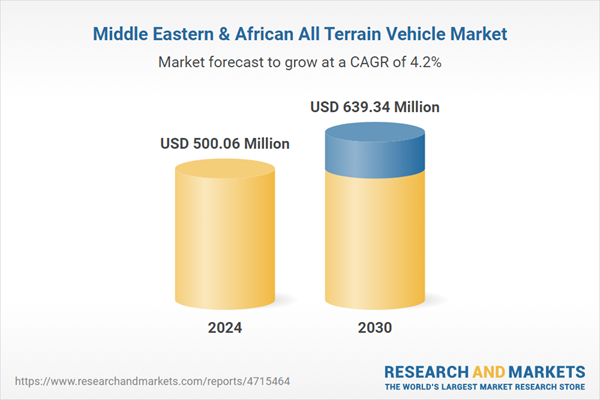Speak directly to the analyst to clarify any post sales queries you may have.
10% Free customizationThis report comes with 10% free customization, enabling you to add data that meets your specific business needs.
Market Drivers
Expanding Utility Applications Across Sectors
All-terrain vehicles are increasingly being adopted beyond recreational use due to their adaptability across a wide range of industries. Sectors such as agriculture, construction, law enforcement, and search-and-rescue now rely on ATVs for efficient mobility in rugged or remote environments where conventional vehicles are impractical. These vehicles provide effective solutions for tasks like transporting tools, inspecting infrastructure, or navigating uneven terrains during emergency operations.Their compact size and maneuverability allow operators to access areas that are typically inaccessible by standard vehicles. In agriculture, ATVs assist in land inspection, fencing, and crop monitoring, improving operational productivity. In construction zones, they support transportation of personnel and equipment across rough terrains. Public safety and military organizations also integrate ATVs for patrolling and quick response in off-road conditions. This multifunctional capability positions ATVs as essential tools in several professional domains, expanding the consumer base beyond hobbyists and recreational riders.
Key Market Challenges
High Purchase and Ownership Costs
One of the primary barriers to widespread adoption of all-terrain vehicles is the high upfront cost, particularly for models equipped with advanced features. In many markets, ATVs are viewed as discretionary purchases, and the price sensitivity of consumers limits potential growth, especially in lower-income segments. Beyond the purchase cost, ongoing ownership expenses such as fuel, maintenance, repairs, and insurance can be considerable. Specialized components like suspension systems, all-terrain tires, and performance engines often demand expert servicing and regular upkeep, which adds to the long-term expenditure. For commercial users, the cost of customizing ATVs for specific industrial applications can further increase total investment. While financing and leasing options are expanding, they remain less prevalent compared to other vehicle segments, limiting affordability.Key Market Trends
Electrification of ATV Powertrains
The push toward electric mobility is beginning to influence the all-terrain vehicle market, with manufacturers launching electric and hybrid ATV models to meet changing consumer and environmental expectations. These electric models offer several advantages over traditional internal combustion engine counterparts, such as reduced emissions, quieter operation, lower maintenance requirements, and better torque delivery at low speeds, making them ideal for both recreational and professional use. Electrified ATVs are especially appealing in settings where noise reduction is important, such as wildlife reserves or residential recreational parks. Technological improvements in battery performance and durability are enabling longer range and faster charging times, making electric ATVs more viable for extended off-road use.Key Market Players
- Textron, Inc.
- Bombardier Recreational Products, Inc.
- Zhejiang CFMoto Power Co., Ltd.
- Polaris, Inc.
- Deere & Company
- Kwang Yang Motor Company Ltd.
- Suzuki Motor Corporation
- Honda Motor Co. Ltd.
- Yamaha Motor Co., Ltd.
- Kawasaki Heavy Industries, Ltd.
Report Scope:
In this report, the Middle East & Africa All Terrain Vehicle Market has been segmented into the following categories, in addition to the industry trends which have also been detailed below:Middle East & Africa All Terrain Vehicle Market, By Product Type:
- Utility ATV
- Sports ATV
Middle East & Africa All Terrain Vehicle Market, By Application Type:
- Entertainment
- Sports
- Agriculture
- Others
Middle East & Africa All Terrain Vehicle Market, By Country:
- South Africa
- Saudi Arabia
- United Arab Emirates
- Turkey
- Rest of Middle East & Africa
Competitive Landscape
Company Profiles: Detailed analysis of the major companies present in the Middle East & Africa All Terrain Vehicle Market.Available Customizations:
With the given market data, the publisher offers customizations according to the company’s specific needs. The following customization options are available for the report.Company Information
- Detailed analysis and profiling of additional market players (up to five).
This product will be delivered within 1-3 business days.
Table of Contents
Companies Mentioned
- Textron, Inc.
- Bombardier Recreational Products, Inc.
- Zhejiang CFMoto Power Co., Ltd.
- Polaris, Inc.
- Deere & Company
- Kwang Yang Motor Company Ltd.
- Suzuki Motor Corporation
- Honda Motor Co. Ltd.
- Yamaha Motor Co., Ltd.
- Kawasaki Heavy Industries, Ltd.
Table Information
| Report Attribute | Details |
|---|---|
| No. of Pages | 135 |
| Published | August 2025 |
| Forecast Period | 2024 - 2030 |
| Estimated Market Value ( USD | $ 500.06 Million |
| Forecasted Market Value ( USD | $ 639.34 Million |
| Compound Annual Growth Rate | 4.1% |
| Regions Covered | Africa, Middle East |
| No. of Companies Mentioned | 10 |









